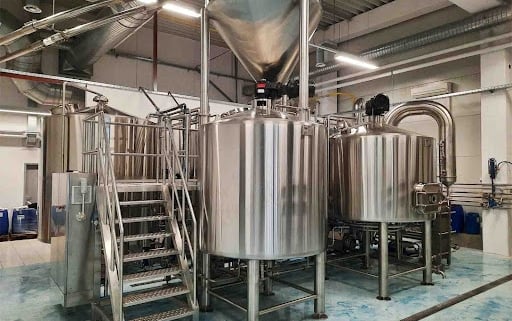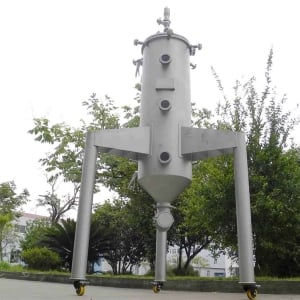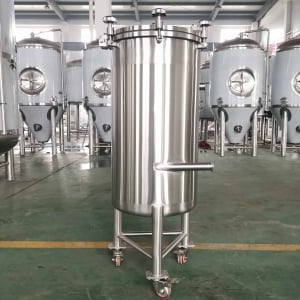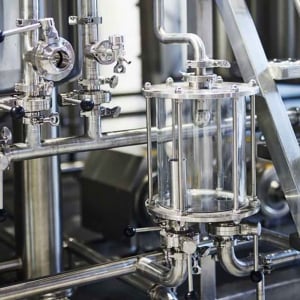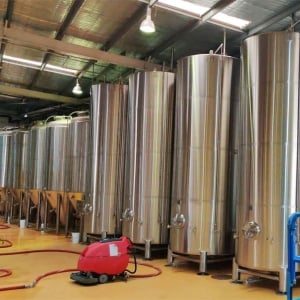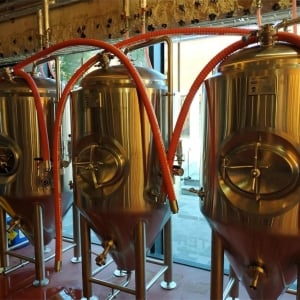Beer Fermentation Tanks
If you’re planning to start brewing beer or already have a brewery, you know that beer fermentation tanks play a pivotal role in the process. These tanks are where the magic happens—the transformation of simple ingredients into delicious beer. But choosing the right fermentation tank isn’t as simple as it may seem. It’s not just about size or capacity, but also factors like materials, design, and customization options.
In this guide, we’ll explore everything you need to know about beer fermentation tanks, from types and specifications to operational tips and choosing the best supplier. Whether you’re a seasoned brewer or just starting, this article will help you make an informed decision.
Overview of Beer Fermentation Tanks
Before diving into the specifics, let’s break down what beer fermentation tanks are and their role in the brewing process. In simple terms, these tanks are designed to hold wort (the liquid extracted from the brewing mash) and allow yeast to ferment the sugars in the wort into alcohol and CO2, creating beer. Different types of tanks cater to different styles of beer, sizes of breweries, and specific brewing needs. The right choice can streamline your operations, increase efficiency, and produce consistently great-tasting beer.
Beer Fermentation Equipment Guide
Choosing the right beer fermentation tank involves understanding the various equipment types available, their features, and how they align with your brewing goals. Here’s a detailed breakdown of the essential equipment you’ll encounter.
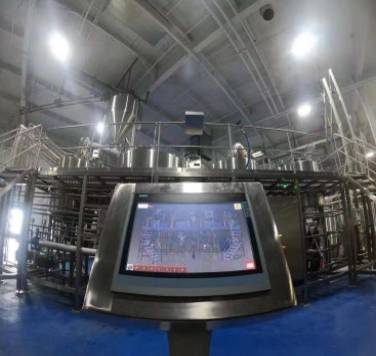
Equipment Types for Beer Fermentation
| Type | Description | Common Uses |
|---|---|---|
| Conical Fermenters | These tanks have a cone-shaped bottom, allowing easy yeast collection and better separation of beer from sediment. | Ideal for breweries that prioritize cleanliness and easy yeast harvesting, commonly used in both small and large breweries. |
| Unitanks | Function as both fermentation and storage vessels. They are highly versatile, allowing the entire fermentation and conditioning process to occur in one tank. | Great for breweries with limited space or those looking to simplify their operations. |
| Horizontal Fermenters | These are long, cylindrical tanks placed horizontally, used primarily for lagering (long-term cold storage). | Typically used in lager production, these tanks help achieve the clean, crisp characteristics of lager beer. |
| Open Fermentation Vessels | These tanks allow direct exposure of the fermenting beer to the air. This traditional fermentation method is often used for specific beer styles, such as Belgian or wild ales. | Popular for traditional styles like Belgian lambics and ales, where open-air fermentation is critical for flavor development. |
| Pressurized Fermenters | Equipped to withstand higher pressures, these tanks allow carbonation during fermentation and produce beer styles that need higher CO2 levels. | Used for producing high-carbonation beers like wheat beers or other effervescent styles. |
Understanding the Brewing Process in Relation to Fermentation Tanks
The brewing process involves several key stages, and fermentation is the most crucial one in defining the beer’s flavor, texture, and alcohol content. To better understand how your fermentation tank fits into this process, here’s a step-by-step breakdown.
Brewing Process Overview
- Mashing: The grains (usually malted barley) are mashed in hot water to extract fermentable sugars. This creates the wort, which will eventually be fermented into beer.
- Boiling: The wort is boiled, and hops are added for flavor, aroma, and bitterness.
- Fermentation: This is where fermentation tanks come into play. After the wort cools down, yeast is added, and the mixture is transferred to the fermentation tanks. The yeast consumes the sugars and produces alcohol, CO2, and various flavor compounds.
- Conditioning: After the primary fermentation, the beer is conditioned, which can either happen in the same tank or be transferred to a different vessel.
- Packaging: Finally, the beer is carbonated (if not already done during fermentation) and packaged in bottles, cans, or kegs for distribution.
During the fermentation process, factors like temperature control, pressure, and sanitation play critical roles in ensuring the beer turns out just right.
Fermentation Tank Design, Layout, and Customization Options
Fermentation tanks come in various sizes, shapes, and designs. Depending on your brewery’s capacity, space limitations, and brewing style, you’ll need to choose a tank that fits your requirements. The right design can improve workflow, allow for easier cleaning, and give you more control over the brewing process.
Tank Design & Layout Considerations
| Aspect | Details |
|---|---|
| Capacity | Tanks range from small-scale, 5-barrel units for craft breweries to large, 100-barrel tanks for commercial operations. Choose a size that aligns with your production goals. |
| Space Requirements | Fermentation tanks can be tall and narrow or short and wide. Evaluate your brewery’s space to ensure tanks will fit and leave enough room for operations, cleaning, and future expansion. |
| Material | Stainless steel is the most common material due to its durability, cleanliness, and corrosion resistance. Some breweries, however, use wooden or copper tanks for specific styles. |
| Temperature Control | Effective temperature control (jacketed tanks with glycol cooling) ensures consistent fermentation and can prevent off-flavors from developing. |
| Pressure Capacity | Depending on your beer style, you may need tanks that can withstand higher pressures to facilitate carbonation during fermentation. |
| Customization Options | Customizable features include sight glasses, sample ports, additional valves, and more, depending on your brewing process and style of beer being produced. |
Beer Fermentation Tanks Price Range and Suppliers
The cost of beer fermentation tanks varies based on size, features, and customization options. Different suppliers offer tanks for every budget, from small craft breweries to large commercial operations.
Fermentation Tank Price Range
| Tank Size | Estimated Price Range | Common Features |
|---|---|---|
| 5-10 barrels | $5,000 – $10,000 | Small craft breweries, basic features like stainless steel body, cone bottom, and simple temperature control. |
| 20-50 barrels | $12,000 – $25,000 | Mid-size breweries, additional features like glycol jackets, customizable ports, and sample valves. |
| 100 barrels and above | $30,000 – $100,000+ | Large commercial breweries, advanced temperature control, pressure resistance, yeast harvesting systems, fully customized layouts. |
Popular Suppliers
| Supplier | Location | Price Range | Customization Options |
|---|---|---|---|
| JVNW | USA | $15,000 – $100,000+ | Extensive customization options, including pressure control and additional ports. |
| China Brewery Equipment | China | $5,000 – $50,000 | Affordable options with various customization features available for small to medium-sized breweries. |
| Blichmann Engineering | USA | $6,000 – $30,000 | Known for small to medium-sized tanks with great attention to temperature control and durability. |
| Paul Mueller Company | USA | $20,000 – $150,000+ | Large-scale tanks, ideal for commercial breweries with high-end customization and advanced operational features. |
Installation, Operation, and Maintenance of Beer Fermentation Tanks
Once you’ve selected the right fermentation tank for your brewery, understanding its installation, operation, and maintenance is crucial to running a smooth operation.
Installation Guidelines
Fermentation tanks are heavy, and proper installation is essential to ensure safety and functionality. Ensure your floor is reinforced to handle the weight and that all plumbing and electrical work (for temperature control) is set up before installation.
Operation Guidelines
Running your fermentation tank involves:
- Temperature Management: Keep the tank at the correct temperature for the type of beer you’re brewing.
- Pressure Control: If you’re using a pressurized fermenter, make sure you’re maintaining safe pressure levels to avoid tank damage or explosion risks.
- Monitoring Fermentation: Keep an eye on the yeast’s activity, which can be tracked through CO2 production and gravity measurements.
Maintenance and Cleaning
Regular cleaning is essential to prevent bacterial contamination and keep your beer tasting fresh. CIP (Clean-in-Place) systems allow for automated cleaning of the tanks without having to dismantle anything. Routine inspections should also be conducted to check for signs of wear or corrosion, especially around ports, valves, and seals.
| Aspect | Details |
|---|---|
| Cleaning | Regular cleaning with CIP systems or manual cleaning with chemicals like caustic soda to prevent contamination. |
| Maintenance | Check seals, valves, and temperature controls regularly to ensure optimal performance and avoid costly repairs. |
| Repairs | In case of corrosion or damage, welding or part replacement may be needed. Maintain a relationship with your supplier for easy access to parts. |
How to Choose the Right Beer Fermentation Tank Supplier
Selecting the right supplier is just as important as choosing the right tank. Here are key factors to consider when choosing a fermentation tank supplier.
| Factor | What to Look For |
|---|---|
| Reputation | Research reviews and testimonials from other breweries to ensure you’re dealing with a reputable company that stands by its products. |
| Customization Options | Look for suppliers that offer extensive customization so that you can tweak the tanks to suit your specific brewing process. |
| After-Sales Service | A good supplier will offer installation support, maintenance, and easy access to spare parts or technical advice. |
| Price | Ensure that the price is competitive, but don’t sacrifice quality for cost savings. |
| Lead Time | Some suppliers may have longer manufacturing and delivery times, especially for customized tanks. Plan accordingly for your brewery’s timeline. |
Comparing Pros and Cons of Different Fermentation Tanks
When choosing between different types of fermentation tanks, it’s essential to weigh the pros and cons of each type to find the one that best suits your brewery’s needs.
| Tank Type | Pros | Cons |
|---|---|---|
| Conical Fermenters | Easy yeast collection, clean fermentation process, widely available. | Generally more expensive than flat-bottom fermenters. |
| Unitanks | Versatile (both fermentation and conditioning in one tank), space-saving. | More complex, requiring advanced operational skills and may be more expensive due to the dual-purpose design. |
| Horizontal Fermenters | Ideal for lagering, better surface area exposure for lager yeast strains. | Takes up more space in your brewery, making it less ideal for small breweries. |
| Open Fermentation Vessels | Unique flavor development, essential for traditional beer styles. | Higher risk of contamination, requires a more controlled brewing environment. |
| Pressurized Fermenters | Great for carbonating beer during fermentation, higher quality control over the final product. | More expensive due to the need for reinforced materials and pressure monitoring systems. |
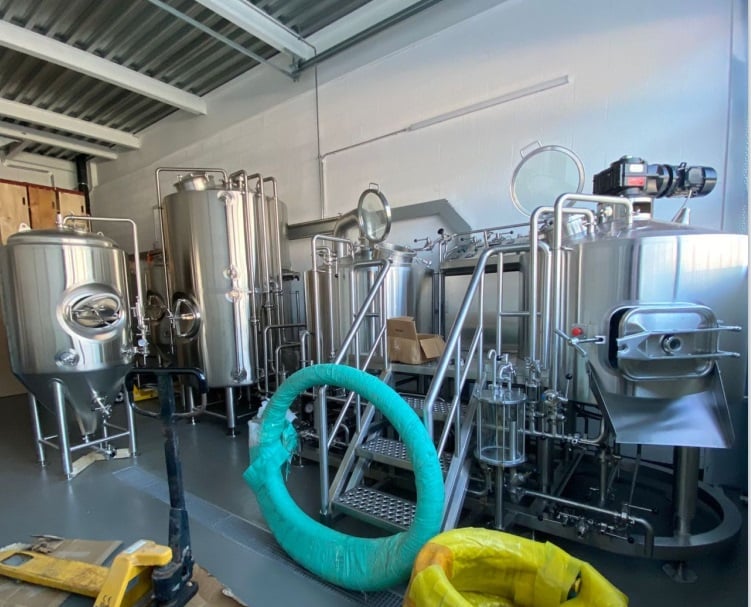
FAQs
| Question | Answer |
|---|---|
| What size fermentation tank do I need? | It depends on your production goals. Small craft breweries may need tanks between 5-10 barrels, while larger operations may require 50-100 barrel tanks for greater output. |
| How often should fermentation tanks be cleaned? | Tanks should be cleaned after every use to avoid contamination and ensure optimal brewing conditions. Automated CIP systems can make the process faster and more efficient. |
| Can I use the same tank for both fermentation and storage? | Yes, if you use a unitank, you can ferment and store beer in the same vessel, which can save space and simplify your operations. |
| Do I need pressurized tanks? | Not all breweries need pressurized tanks, but if you’re brewing high-carbonation beers or need tight control over CO2 levels, pressurized fermenters are a good option. |
| How do I know if my tank is the right temperature? | Most tanks come with built-in thermometers and temperature control systems (glycol jackets) to help you monitor and adjust the fermentation temperature in real-time. |
By understanding the role of beer fermentation tanks in the brewing process and carefully evaluating your equipment options, you’ll be well on your way to creating a successful brewing operation. Whether you’re starting small with a few barrels or scaling up to large commercial production, the right tank is essential to crafting great beer.

